Recent Articles
Popular Makes
Body Types
2021 Ford Bronco Sport Road Test and Review
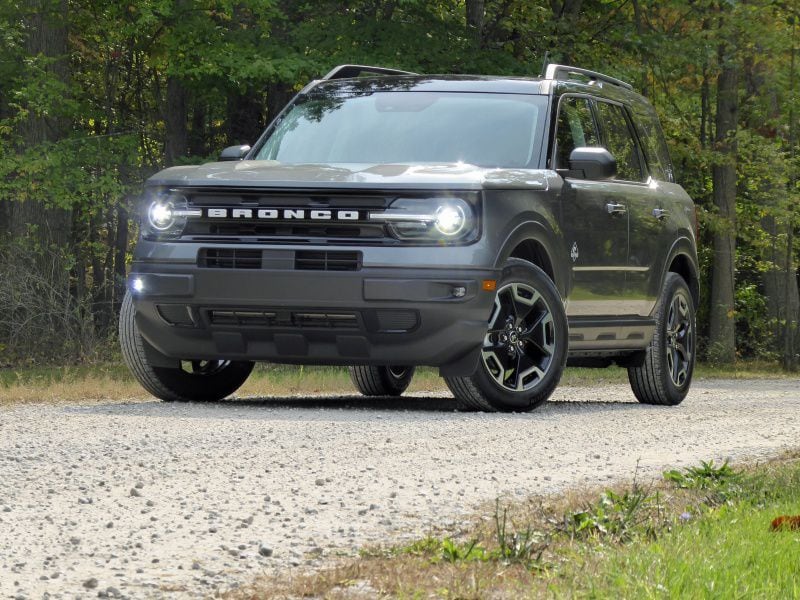
2021 Ford Bronco Sport ・ Photo by Ron Sessions
Not to be confused with the Ranger-based 2021 Ford Bronco sport-utility due out midway into the 2021 calendar year is the compact 2021 Ford Bronco Sport. Now on sale at U.S. dealers, the all-new Bronco Sport shares its iconic name, four-wheel-drive off-road capability, and design cues with the larger, mid-size Bronco, but little else.
As with most small crossover utilities in this large and growing segment, the Bronco Sport forgoes the heavy truck frame for lightweight, unitized construction and a transversely mounted engine, packing a lot of passenger and cargo space into a small footprint. It borrows key under-the-skin bits from the Ford Escape SUV and European/Asian-market Ford Focus hatchback — upsized and bolstered for off-road duty. The model lineup consists of the base Bronco Sport, midlevel Big Bend, premium Outer Banks, and off-road-oriented Badlands. A limited run of 2,000 top-of-the-line First Edition models combining Outer Banks uplevel trim and Badlands off-road prowess is already sold out. Including the not-insignificant $1,495 destination charge, 2021 Bronco Sport prices range from $28,315 to $34,315. Ford has also developed a large selection of optional accessories such as tents, bike racks, cargo dividers, and rooftop carriers for Bronco Sport buyers to choose from. Major competitors include the Jeep Compass, Jeep Renegade, and Jeep Cherokee.
Bronco Sport Design
Not every automaker has a half-century-old design icon it can summon from its archives to stir the ever more crowded SUV market. But Ford does, and the all-new 2021 Bronco Sport is proof positive the 120-year-old automaker wants a piece of the off-road-capable small SUV market Jeep has had almost entirely to itself in recent times. The Bronco Sport channels the upright, squared-off shapes of the first-generation 1966-77 two-door Bronco right down to the flat hood and round, cheeky headlamps. Sitting tall on a beefed-up unitized-body chassis with an abundance of ground clearance, a tall, safari-style roof and an added pair of doors enhance utility. And for those out there unaware of the Bronco’s storied past, Ford spells it all out in huge, upper-case B-R-O-N-C-O letters dominating the grille.
Lengthwise, the diminutive Bronco Sport four-door stretches just a few inches longer than a Mini Countryman and nearly a half foot shorter than a Honda Civic hatchback. Nose to tail, the Bronco Sport matches most closely with the Jeep Compass, but its raised roof gives the new Ford about 20 percent more cargo space than the Jeep behind the rear seat. The Bronco Sport’s safari-style roof also hands it an overall cargo space advantage over the larger Jeep Cherokee.
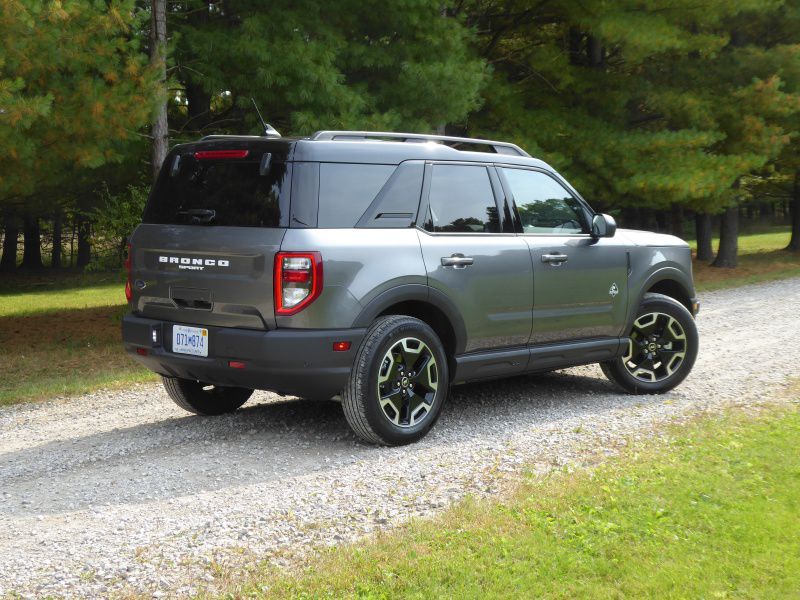
Photo by Ron Sessions
Under the Hood
The Bronco Sport’s powertrain lineup is straight out of the Ford Escape. There are two turbocharged engines: a 1.5-liter three-cylinder with 181 horsepower and 190 lb-ft of torque in the base, Big Bend, and Outer Banks trims, and a 2.0-liter four-cylinder with 250 hp and 277 lb-ft of torque in the Badlands model. Both engines are teamed with a crisp-shifting eight-speed step-shift automatic transmission controlled by a console twist knob, the Badlands adding steering-wheel paddles for optional manual shift control. All trims feature standard 4WD.
The base three-cylinder turbo delivers adequate performance and can achieve 60 mph from rest in around 8.5 seconds, just a tad slower than a Toyota RAV4. More invigorating is the uplevel four-cylinder turbo which can accelerate the Badlands model to 60 mph in about 7 seconds, quicker than the Jeep Cherokee V6. Even though the Bronco Sport is relatively lightweight compared to most other SUVs, its squared-off body, tall roof, and traction-focused tires don’t help fuel economy. EPA estimates are 25 mpg city/28 mpg highway/26 mpg combined for the 1.5-liter three-cylinder turbo and 21 mpg city/26 mpg highway/23 mpg combined for the 2.0-liter four-cylinder turbo. Both engines can run on unleaded regular but Ford recommends unleaded premium for the 2.0-liter.
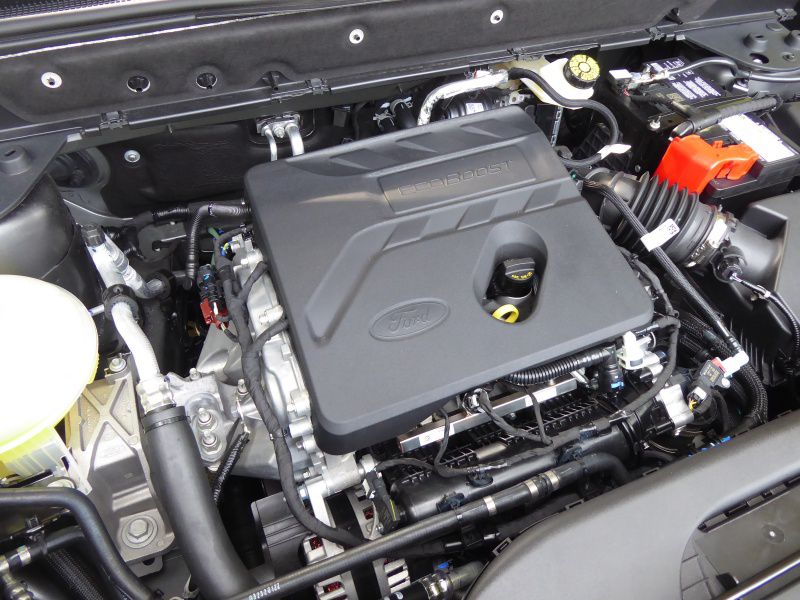
Photo by Ron Sessions
Cabin Considerations
The Bronco Sport’s cheeky exterior may suggest a half-price Land Rover, but a preponderance of hard plastic trim inside on the doors, dash, and console leaves no doubt this Ford is aimed at the more affordable end of the SUV spectrum. While not fancy, the small 4x4’s cabin fitments look appropriately durable, easy to clean, and up to the task of handling messy off-road excursions.
Cloth seat coverings are standard on the base, Big Bend, and Badlands models, while leather hides are included with the Outer Banks trim. Particularly striking are the two-tone Outer Banks interior color combinations that include some adventurous shades of green, brown, and blue. The Big Bend adds niceties such as push-button start, automatic climate control, Ford’s keypad entry, a rubberized cargo floor, a leather-wrapped steering wheel, and zippered pockets and MOLLE straps on the front seatbacks. The Outer Banks brings heated, power front seats, a heated steering wheel, dual-zone auto climate control, remote start, ambient lighting, and rain-sensing wipers. The off-road-focused Badlands reverts to cloth seat coverings but keeps heated seats up front and a power driver’s seat, while adding rubberized flooring throughout and added storage under the rear seat.
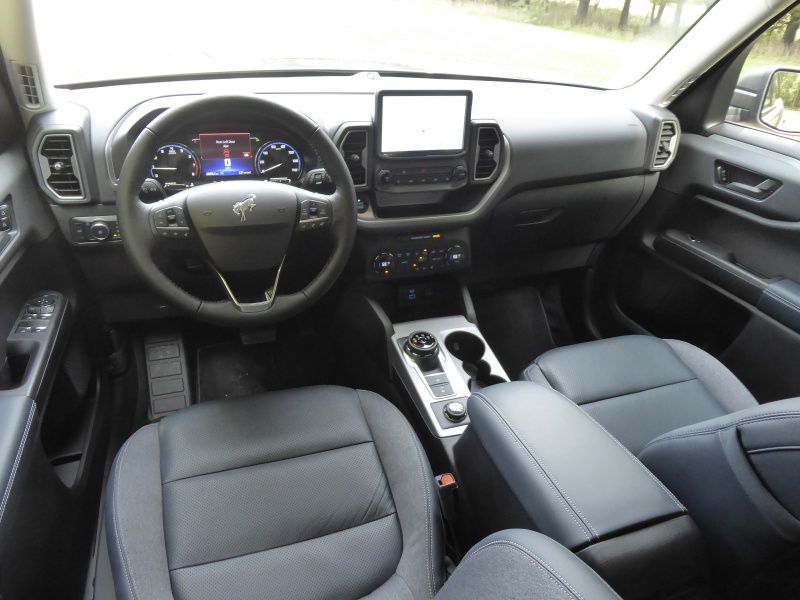
Photo by Ron Sessions
Infotainment
Built around Ford’s Sync 3 infotainment system, all Bronco Sport trims come with an 8-inch capacitive touchscreen display with pinch and swipe functions as well as steering wheel and voice controls. Easy-to-grip redundant analog volume and tuning knobs make audio adjustments less fumbly on bumpy back roads.
The base sound system is a six-speaker AM/FM stereo with a pounding 10-speaker B&O Bang & Olufsen premium audio system and HD radio optional. All but the base trim add SiriusXM satellite radio. There are four USB ports in the center console, one each Type-A and the newer Type-C for both front and rear-seat occupants. With a valid data plan, FordPass Connect onboard 4G LTE Wi-Fi is standard fare and all audio systems are compatible with Apple CarPlay and Android Auto cellphone mirroring.
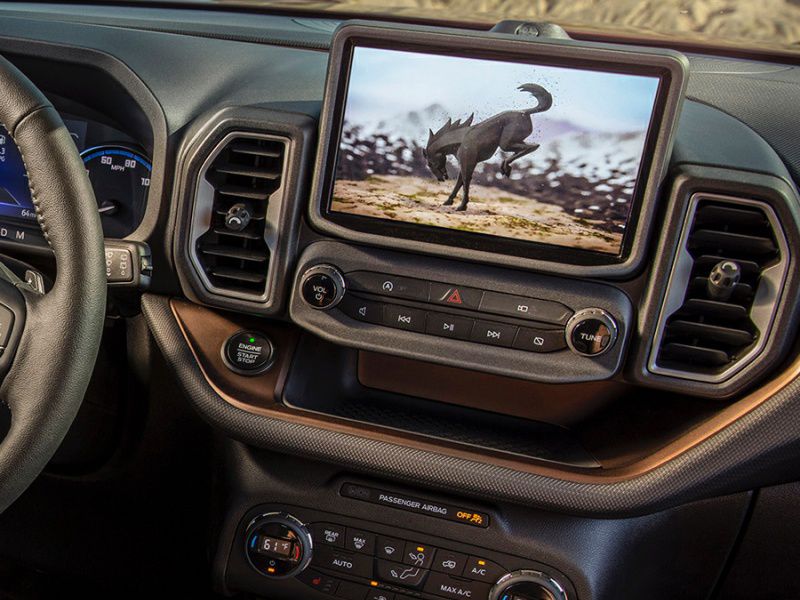
Photo by Ford
Back-Seat Bronco Busting
While a short wheelbase gives the Bronco Sport maneuverability and ground-clearance breakover angle benefits, it does crimp rear legroom a bit — down nearly 2 inches from that offered in the Ford Escape.
Concave pockets skived into the front seatbacks gain back some precious knee room for rear passengers. And a tall, safari-style roof enables generous rear headroom: 2.5 inches greater than that in the Escape. Technically, the Bronco Sport has five-passenger capability, but the rear seat can comfortably handle just two adults. Dark-tint privacy glass for the rear doors and cargo area is standard in Big Bend and higher trims. Standard are 60/40 split-folding rear seatbacks with a fold-down center armrest.
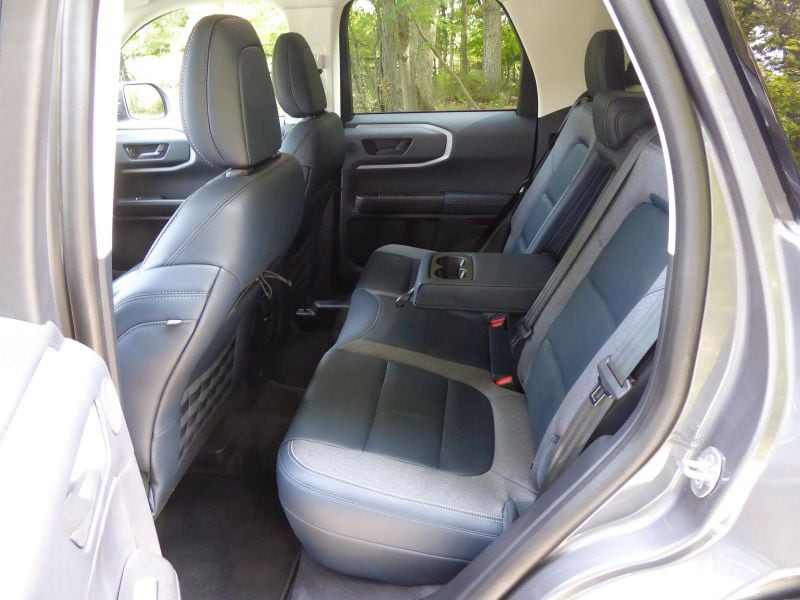
Photo by Ron Sessions
Roomy Cargo Hold
The Bronco Sport offers an ample 65.2 cubic feet of cargo space behind the front seats with the 60/40 split rear seatbacks folded down and 32.5 cubic feet behind the raised rear seat. That’s just a shade less than offered in the Escape the Bronco Sport is based on. The rear seats don’t fold totally flat but make for a space large enough to carry two mountain bikes standing up in the cargo bay with the front wheels removed.
One cool feature from SUVs of a couple decades ago (and still offered just on a few Toyota legacy models) is a separate-opening glass window inside the Bronco Sport’s rear liftgate. This allows owners to drop small items into the cargo bay without raising the entire liftgate, handy for when there’s not much space behind the vehicle for access or if the cargo hold is already filling up. A rubberized cargo floor covering standard in Big Bend and higher trims can take dirt, stains, and spills in stride. Standard adjustable flood lamps under the liftgate shine a helpful light on loading and unloading cargo items. Another neat feature is a bottle opener built into the rear hatch.

Photo by Ron Sessions
Safety and Driver-Assist Systems
These days, buyers expect a full complement of safety and driver-assist technology and the Bronco Sport doesn’t disappoint. Ford Co-Pilot 360 content is standard with all trims, including a forward-collision warning, pre-collision assist with pedestrian detection and automatic emergency braking, lane-keeping, automatic high beams, a backup camera, and blind-spot and rear cross-traffic monitoring.
For $795 extra, buyers of Big Bend, Outer Banks, and Badlands models can add Ford Co-Pilot 360 Assist +, which adds adaptive cruise control, speed sign recognition (except on Big Bend), evasive steering assist, and voice-activated navigation with SiriusXM traffic and travel-link services. Badlands models also throw in standard reverse sensing for help with backing into parking spaces, plus a self-washing front camera for viewing steep drop-offs or tricky terrain close to the front bumper. The National Highway Traffic Safety Administration has not yet released crash-test ratings for the 2021 Bronco Sport, but the Ford Escape it’s based on achieved a top five-star score overall with five stars for front and side impacts and four stars for rollover resistance.
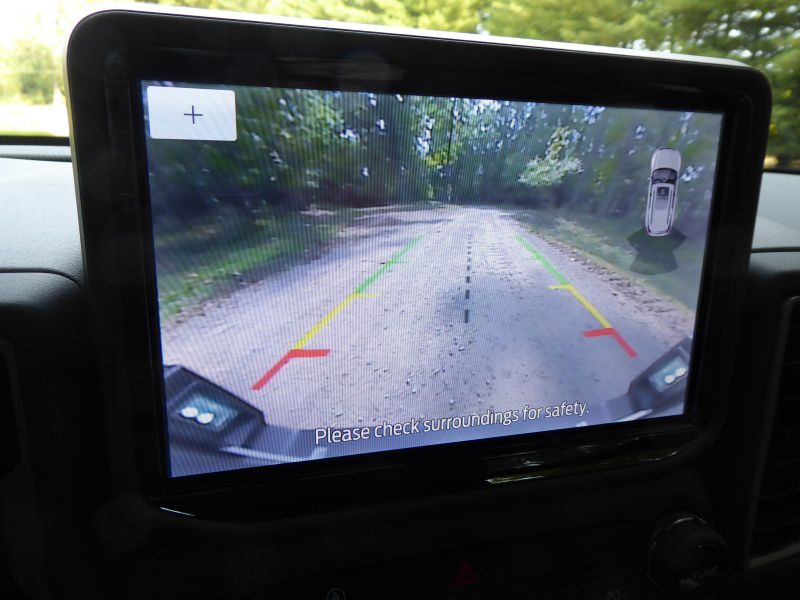
Photo by Ron Sessions
Getting Your GOAT
These days, a lot of vehicles — cars, pickups, and SUVs alike — offer selectable driving modes. The Bronco Sport’s Terrain Management system has a control knob on the console for selecting the appropriate G.O.A.T. (catchy and short for Goes Over Any Terrain) mode for the conditions at hand. Ford product planners and copywriters obviously had fun with this.
The base Bronco Sport, Big Bend, and Outer Banks trims get five GOAT selections — Normal, Eco, Sport, Slippery, and Sand — while the 1-inch-lifted Badlands model adds two more: Mud/Ruts and Rock Crawl, which take advantage of that model’s added off-road capability. The GOAT settings provide customized algorithms for throttle mapping, transmission shift schedules, and 4WD traction-control settings for each driving scenario.
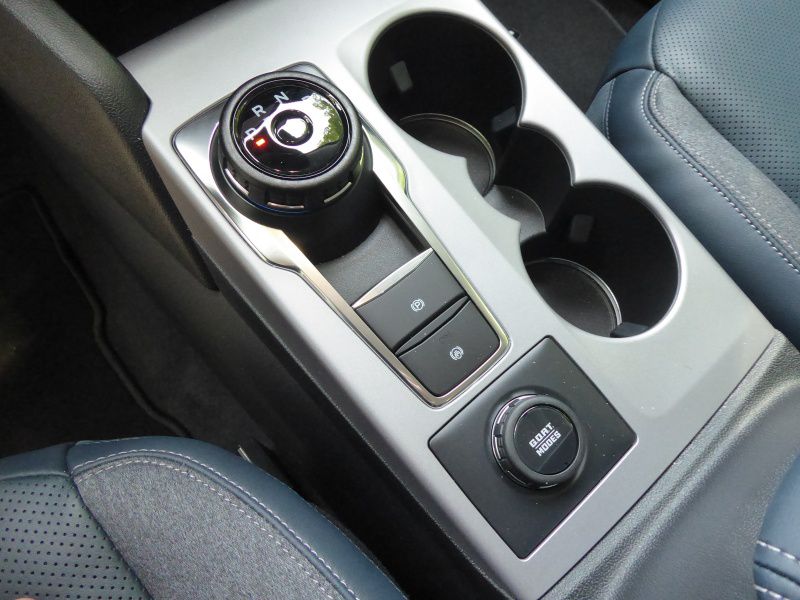
Photo by Ron Sessions
Driving Dynamics
Despite the base Bronco Sport’s ample 7.8 inches of ground clearance, seating height is compact SUV-appropriate. Ingress and egress is a breeze courtesy of unitized construction that eliminates the bulky ladder frame found in truck-based SUVs like the senior Bronco. The base 1.5-liter three-cylinder turbo may sound a bit like a sewing machine but works just fine around town, with ample low-end torque. Up top, the three-cylinder runs low on steam, so freeway merging and two-lane passing require planning. Putting the three-cylinder in Sport mode helps a bit, keeping lower gears longer before shifts but dinging fuel economy.
The beefier-sounding (and performing) 2.0-liter four-cylinder turbo in the Badlands has all the power you’ll need on- or off-road. The Badland’s specially tuned off-road suspension and extra inch of body lift add to the Bronco Sport’s already impressive 4WD operation and approach, breakover, and departure angles. Both the base and Badlands four-wheel independent suspension setups provide firm damping but relatively soft spring rates for good rough-terrain articulation and decent on-road ride quality. The Badlands includes an advanced twin-clutch 4WD rear-drive unit from the former Ford Focus RS that can send power to the rear wheel with the most traction or lock the differential for surfaces like sand. Another Badlands plus is Trail Control, which allows the driver to set any speed up to 20 mph and concentrate on steering around obstacles.
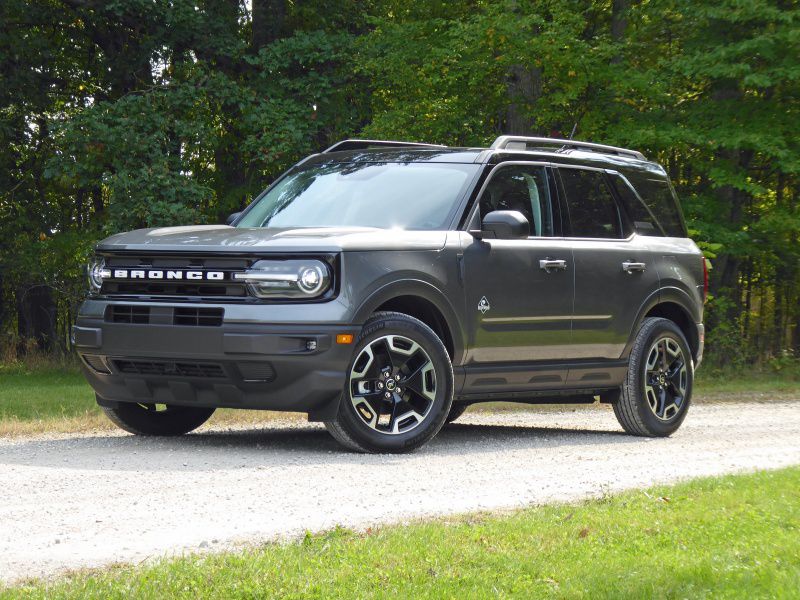
Photo by Ron Sessions
Bronco for the Masses
Off-road enthusiasts may be chomping at the bit anticipating the rollout of the mid-size, Ranger-based “big” Bronco later this year, but the 2021 Bronco Sport is likely the one that a majority of compact SUV and crossover buyers will want to drive day in and day out. It offers the sort of passenger and cargo space, smooth-riding all-independent suspension, and good fuel economy expected of the class, along with a modicum of off-road ability for occasional sojourns into the outback that’s way more capable than most competitors. Plus, it’s got that iconic Bronco look that will stand out from the crowd.
Campers take note: A Class II towing package including a rear hitch receiver and full-size spare is a $395 option for Big Bend, Outer Banks, and Badlands models, giving 2,000-lb towing ability with the three-cylinder and 2,200-lb towing with the four-cylinder for a small trailer.
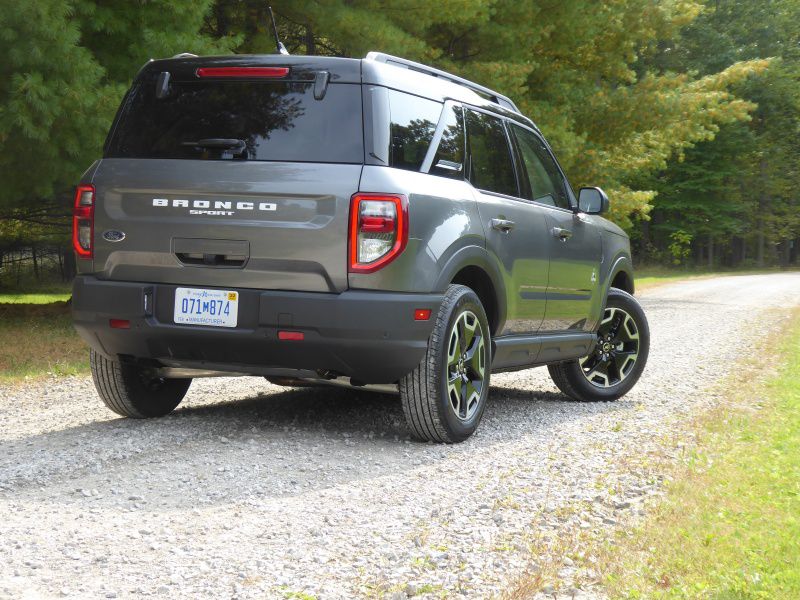
Photo by Ron Sessions